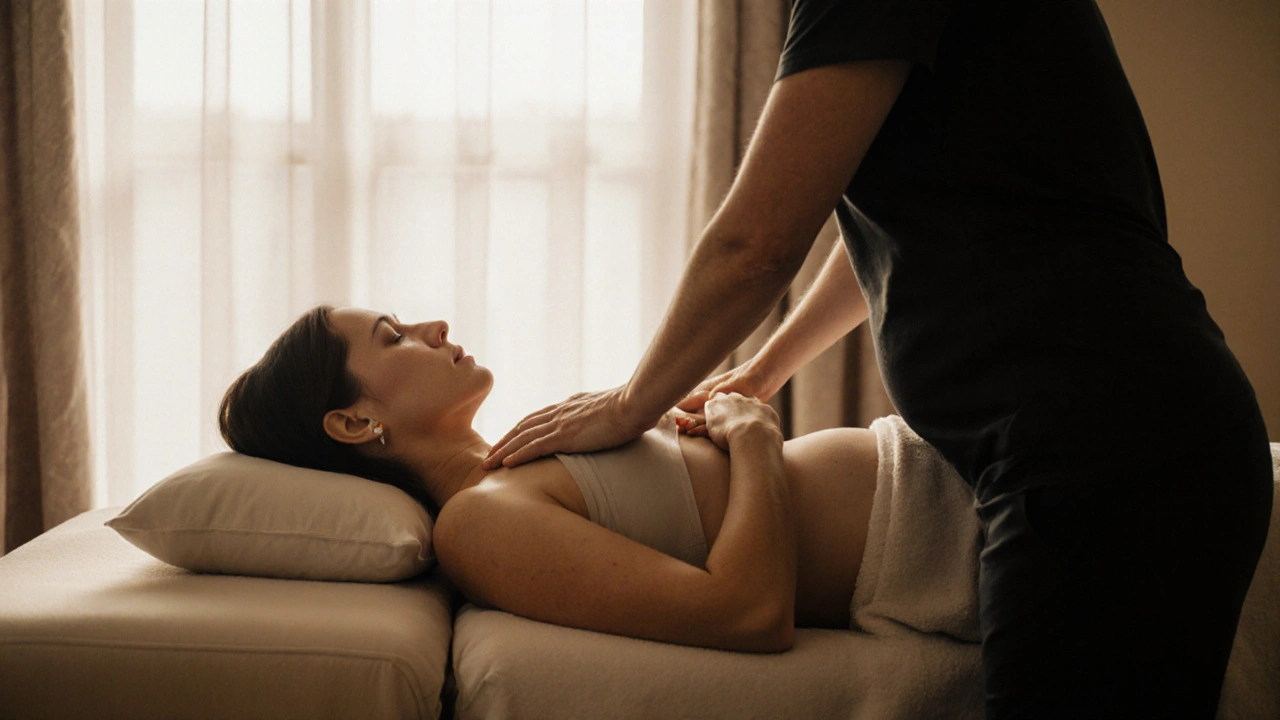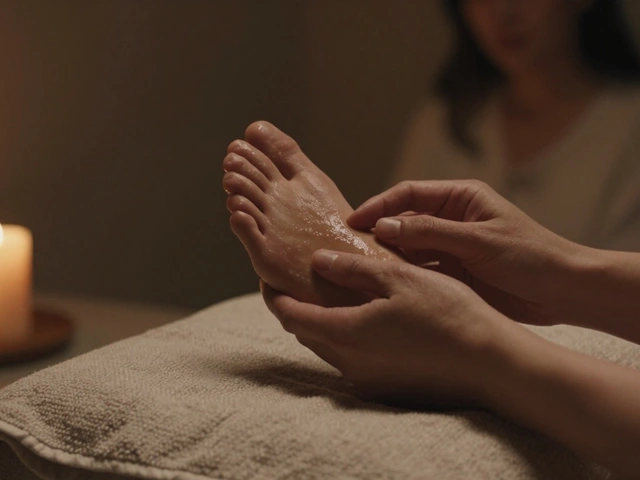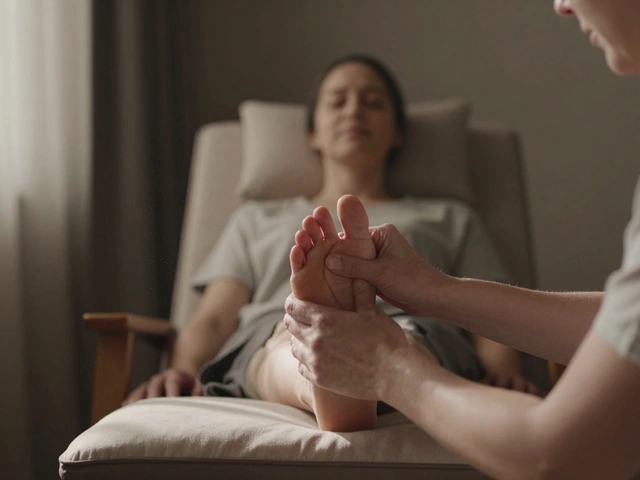Prenatal Massage Safety Checker
Is Prenatal Massage Safe for You?
Answer a few questions to determine if prenatal massage is appropriate for your pregnancy.
When you're pregnant, your body changes in ways no one ever prepares you for. Back pain. Swollen feet. Trouble sleeping. Anxiety that won’t quit. You might think these are just part of the deal - something you have to push through. But what if there’s a simple, safe, and deeply effective way to ease all of it? Enter prenatal massage.
What Exactly Is Prenatal Massage?
Prenatal massage isn’t just a regular massage with a pregnancy pillow under your belly. It’s a specialized form of bodywork designed specifically for expectant mothers. Trained therapists use gentle pressure, proper positioning, and targeted techniques to address the unique physical and emotional changes happening during pregnancy.
Unlike standard massage, prenatal massage avoids deep tissue work on the abdomen and inner thighs. Instead, it focuses on areas most affected by pregnancy: the lower back, hips, shoulders, and legs. The goal? To reduce swelling, improve circulation, and release tension without putting any strain on the mother or baby.
It’s not new. Ancient cultures have used massage for pregnant women for centuries. Today, modern research backs it up. A 2023 study published in the Journal of Obstetric, Gynecologic & Neonatal Nursing found that women who received weekly prenatal massage for eight weeks reported a 37% drop in cortisol levels - the body’s main stress hormone - compared to those who didn’t.
How Prenatal Massage Improves Maternal Health
Maternal health isn’t just about avoiding complications. It’s about how you feel - physically, mentally, and emotionally - throughout pregnancy. Prenatal massage touches all of it.
Reduces chronic pain - As your belly grows, your center of gravity shifts. That pulls your spine out of alignment. The result? Lower back pain, sciatica, and pelvic discomfort. A 2024 clinical review in Complementary Therapies in Clinical Practice showed that 83% of pregnant women who received regular prenatal massage saw significant improvement in lower back pain within four weeks.
Lowers stress and anxiety - Pregnancy can be overwhelming. Hormones spike. Sleep disappears. Worries multiply. Massage triggers the release of serotonin and dopamine - the brain’s natural mood boosters. At the same time, it slashes cortisol. One Australian study tracked 120 pregnant women in Perth. Those who had biweekly massages reported 44% less anxiety and improved sleep quality.
Decreases swelling - Edema - that puffiness in your hands and feet - is common. It happens because your body holds onto more fluid. Massage helps move that fluid along. Light, rhythmic strokes toward the heart encourage lymphatic drainage. Women who got regular sessions noticed less swelling and fewer nighttime leg cramps.
Improves circulation - Blood volume increases by up to 50% during pregnancy. That’s good for the baby, but tough on your veins. Massage helps blood flow more efficiently, reducing the risk of varicose veins and dizziness. It also boosts oxygen delivery to muscles and organs, helping you feel less fatigued.
Supports better labor outcomes - This one surprises people. Women who received consistent prenatal massage were 31% less likely to experience prolonged labor, according to a 2022 analysis from the Australian College of Midwives. Why? Lower stress means fewer stress-induced hormonal disruptions during labor. Plus, relaxed muscles mean less resistance during delivery.
Who Should Avoid Prenatal Massage?
Most pregnant women can safely enjoy prenatal massage - but not everyone. There are important exceptions.
If you have:
- High-risk pregnancy (preeclampsia, placenta previa, or preterm labor)
- Uncontrolled high blood pressure
- Deep vein thrombosis or blood clotting disorders
- Severe gestational diabetes with complications
- Recent vaginal bleeding or unexplained abdominal pain
...you should check with your doctor or midwife first. Even then, some therapists may still work with you using extra caution.
Also, avoid massage in the first trimester if you’re prone to miscarriage or have a history of it. While there’s no proven link between massage and early loss, many therapists wait until after week 12 as a precaution.
What to Expect in a Session
Don’t walk into your first session expecting to lie face-down on a table. That’s not safe - and not possible - after the first trimester.
Most clinics use specialized pregnancy massage tables with cutouts for your belly and breasts. Or, you’ll lie on your side with pillows propping you up. You’re never flat on your back - that can compress the vena cava and lower blood pressure.
The therapist will use hypoallergenic oils or lotions. They’ll avoid pressure points linked to labor induction (like the space between your thumb and index finger). And they’ll adjust pressure based on your comfort - never deep or painful.
A typical session lasts 60 to 90 minutes. You’ll feel relaxed, maybe even a little emotional. That’s normal. Your body is doing something incredible, and massage helps you tune into that.

How Often Should You Get It?
There’s no one-size-fits-all answer. But here’s what most experts recommend:
- First trimester (weeks 1-12): Optional. If you’re feeling okay, once a month is fine. Skip if you’re nauseous or fatigued.
- Second trimester (weeks 13-28): Ideal time to start. Once every two weeks helps manage growing discomfort.
- Third trimester (weeks 29-40): Weekly sessions are most beneficial. This is when pain, swelling, and anxiety peak.
Some women start weekly in week 36 - especially if they’re carrying twins or have a physically demanding job. Others prefer to wait until week 20. There’s no rush. Listen to your body.
Can Your Partner Give You Prenatal Massage?
Yes - and it’s powerful. A partner’s touch, even if it’s not perfect, releases oxytocin - the bonding hormone. That helps both of you feel closer during a time that can feel isolating.
Simple techniques work wonders:
- Hand and foot rubs with coconut oil
- Light shoulder and neck strokes while you’re seated
- Side-lying back rubs with a pillow under the belly
Just avoid deep pressure on the lower back or abdomen. And never try to "pop" your back or hips. That’s not massage - that’s risky.
Many hospitals and doula groups offer free partner massage workshops. Ask your midwife. It’s one of the most meaningful gifts you can give each other.
Real Stories, Real Results
In Perth, 32-year-old Leah started prenatal massage at 24 weeks. She was working 50-hour weeks as a nurse. Her back hurt constantly. She couldn’t sleep. She was crying every night.
After six weeks of weekly sessions, she told her midwife: "I feel like myself again. Not the tired, angry version. The one who laughs at silly jokes and dances in the kitchen."
Another client, Maria, had severe sciatica. She couldn’t walk more than 10 minutes without pain. After eight sessions, she walked her daughter to school for the first time in months. "I didn’t think I’d ever feel normal again," she said.
These aren’t outliers. They’re the norm.

Is Prenatal Massage Covered by Insurance?
In Australia, some private health funds cover prenatal massage under "extras" policies - especially if it’s provided by a registered physiotherapist or myotherapist. Check your policy. You might need a referral from your GP or midwife.
Medicare doesn’t cover it directly. But if you’re on a Chronic Disease Management plan, your doctor can include massage as part of your care team. That means you can claim a rebate.
Many clinics offer sliding scale fees or pregnancy packages. Don’t assume it’s too expensive. A single session might cost $80-$120, but the return - in sleep, pain relief, and peace of mind - is priceless.
Where to Find a Qualified Therapist
Not every massage therapist is trained in prenatal work. Look for someone who:
- Has specific prenatal certification (like from the Australian Association of Massage Therapists)
- Uses pregnancy-specific tables or positioning
- Asks about your medical history and pregnancy risks
- Doesn’t pressure you into packages or unnecessary treatments
Ask your midwife, obstetrician, or local parenting group for recommendations. Word of mouth is the best filter.
And if you’re in Perth, clinics like Body Balance Perth and Pregnancy Wellness Centre have been doing this for over 15 years. They know the local needs - from the heat to the long work hours.
Why This Matters Beyond Pregnancy
Prenatal massage isn’t just about feeling better while you’re pregnant. It sets the tone for postpartum recovery. Women who received regular massage during pregnancy report:
- Faster healing after birth
- Lower rates of postpartum depression
- Stronger bonding with their newborn
Why? Because when your body feels supported during pregnancy, you enter motherhood with more resilience. Less pain. Less stress. More energy to hold, feed, and comfort your baby.
This isn’t luxury. It’s care. And it’s something every pregnant person deserves.
Is prenatal massage safe during the first trimester?
Yes, but many therapists wait until after week 12 as a precaution, especially if you have a history of miscarriage or are experiencing severe morning sickness. There’s no evidence that massage causes early loss, but it’s common practice to wait. Always check with your doctor first.
Can prenatal massage induce labor?
No, not when done properly. Licensed prenatal massage therapists avoid pressure points linked to labor induction, such as the SP6 point on the inner ankle. If you’re near your due date and want to encourage labor, you’ll need a different approach - and you should only do it under professional guidance.
How is prenatal massage different from regular massage?
Prenatal massage avoids deep pressure on the abdomen and inner thighs. It uses side-lying or semi-reclined positions instead of lying flat on your back or stomach. The strokes are gentler, focused on relieving pregnancy-specific discomforts like swelling, back pain, and pelvic tension. It’s not just a softer version - it’s a completely different technique.
Can I get a prenatal massage if I’m carrying twins?
Yes - and it’s often even more beneficial. Twin pregnancies put extra strain on the back, pelvis, and circulation. Weekly sessions can help manage swelling, reduce pain, and improve sleep. Make sure your therapist has experience with multiples and knows how to adjust positioning for larger bellies.
Do I need a referral from my doctor to get prenatal massage?
Not always, but it helps - especially if you want to claim a rebate through Medicare or private health insurance. If you have a high-risk pregnancy or chronic condition, your doctor should approve it. Even if you’re low-risk, sharing your medical history with your therapist ensures your session is safe and effective.








